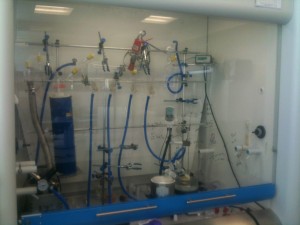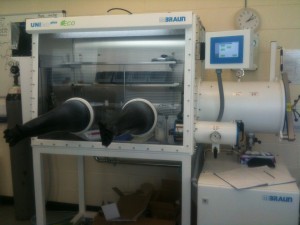We use techniques in synthetic chemistry to make new compounds and use additional analytical techniques to characterise what we have made.
Highly Air-Sensitive Chemistry
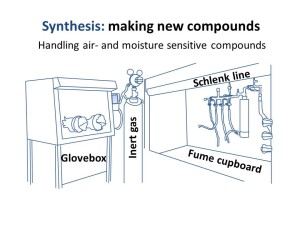
Many of the compounds we deal with are air- and moisture-sensitive, so we need to protect these compounds from exposure to the air which contains oxygen (around 21%) and moisture (H2O in the air). We usually use glassware to contain an inert atmosphere (such as completely dry and oxygen free nitrogen or argon because they are relatively unreactive, inert gases) and this also allows us to see what is going on! Reaction vessels that easily allow the atmosphere to be removed and replaced with an inert gas is named after Wilhelm Schlenk, along with the manifold that allows vacuum and gas to be delivered to the flask, called a Schlenk line.
We can also use a glovebox to exclude air and moisture from reacting with our compounds. Originally developed for the nuclear industry to keep radionuclides in, gloveboxes for oragnometallic chemistry purify the gas that goes into the glovebox along with the atmosphere inside to keep oxygen and water out. Although expensive, they are very useful as reactions can be performed in simple vials and flasks without the need to use extra taps and seals.
Characterisation Techniques
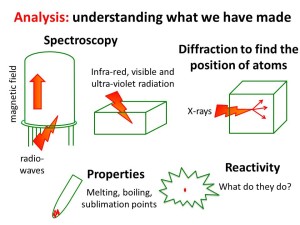
Multinuclear NMR Spectroscopy
Many advanced, multinuclear NMR spectroscopic techniques and equipment are utilised, including non-standard nuclei (below are examples of 119Sn spectra for divalent tin species), and multi-dimensional NMR techniques, such as Diffusion Order NMR spectroscopy.
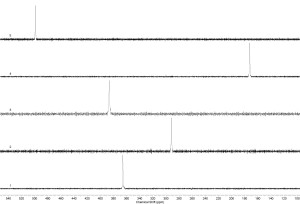
X-ray Crystallography
X-ray crystallography is a highly useful technique. We perform the X-ray diffraction experiments ourselves on new compounds we make and then solve and refine the resulting structures. Attending the BCA Intensive Course on X-ray Crystallography is highly recommended to supplement the practical skills you learn from hands-on practice.
Mass Spectrometry
Mass Spectrometry, including different ionisation techniques such as E.I., C.I., E.S.I. and MALDI, are used to characterise the variety of different types of molecules in our work.
Other Spectroscopic Methods
We have used a variety of other spectroscopic techniques, such as I.R., UV-vis, E.P.R. and Mossbauer spectroscopy to provide useful information on specific types of compounds.
Computational Chemistry
We collaborate with many other computational experts as well as occasionally use the programmes ourselves to assess bond strengths, energies and molecular properties in organometallic systems.

